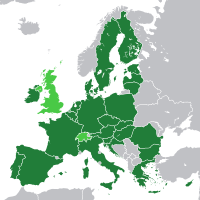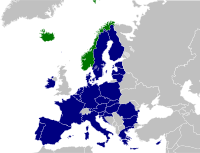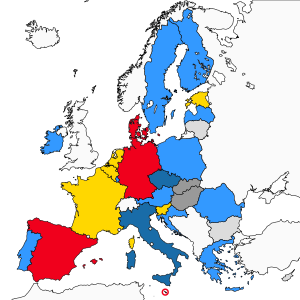European Council
[1] Established as an informal summit in 1975, the European Council was formalised as an institution in 2009 upon the commencement of the Treaty of Lisbon.
While the European Council has no legislative power, it is a strategic (and crisis-solving) body that provides the union with general political directions and priorities, and acts as a collective presidency.
[2][3] The meetings of the European Council, still commonly referred to as EU summits, are chaired by its president and take place at least twice every six months;[1] usually in the Europa building in Brussels.
At the December summit in Paris in 1974, following a proposal from then-French president Valéry Giscard d'Estaing, it was agreed that more high-level, political input was needed following the "empty chair crisis" and economic problems.
[11] Following the ratification of the treaty in December 2009, the European Council elected the then-Prime Minister of Belgium Herman Van Rompuy as its first permanent president; he resigned the prime ministerial position.
[12] The European Council is an official institution of the EU, described in the Lisbon Treaty as a body which "shall provide the Union with the necessary impetus for its development".
[1] Beyond the need to provide "impetus", the council has developed further roles: to "settle issues outstanding from discussions at a lower level", to lead in foreign policy — acting externally as a "collective Head of State", "formal ratification of important documents" and "involvement in the negotiation of the treaty changes".
However, since the Treaty of Lisbon, this has been discontinued, as the size of the body had become somewhat large following successive accessions of new Member States to the Union.
At the push of a button members can also call for advice from a Permanent Representative via the "Antici Group" in an adjacent room.
[1] As the composition is not precisely defined, some states which have a considerable division of executive power can find it difficult to decide who should attend the meetings.
[citation needed] This was despite Stubb being Chair-in-Office of the Organisation for Security and Co-operation in Europe at the time which was heavily involved in the crisis.
[citation needed] The President of the European Council is elected by its members through a qualified majority vote for a once-renewable term of two and a half years.
The President-in-Office was primarily responsible for preparing and chairing the Council meetings, and had no executive powers other than the task of representing the Union externally.
The European Council is required by Article 15.3 TEU to meet at least twice every six months, but convenes more frequently in practice.
[29] An advanced implementation of this agreement occurred in 2002, with certain states agreeing to waive their right to host meetings, favouring Brussels as the location.
[31] The logistical, environmental, financial and security arrangements of hosting large summits are usually cited as the primary factors in the decision by EU leaders to move towards a permanent seat for the European Council.
[7] Additionally, some scholars argue that the move, when coupled with the formalisation of the European Council in the Lisbon Treaty, represents an institutionalisation of an ad hoc EU organ that had its origins in Luxembourg compromise, with national leaders reasserting their dominance as the EU's "supreme political authority".
[32] However, in 2004 leaders decided the logistical problems created by the outdated facilities warranted the construction of a new purpose built seat able to cope with the nearly 6,000 meetings, working groups, and summits per year.
[33] The EU command and control (C2) structure is directed by political bodies composed of member states' representatives, and generally requires unanimous decisions.






